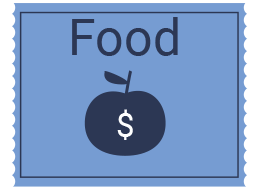
What Is Prescription Drug Plans Coverage?
Medicare prescription drug coverage is an optional benefit offered to everyone who has Medicare (people of 65+ years of age).To get Medicare drug coverage, you must join a Medicare plan that offers prescription drug coverage. Each plan can vary in cost and drugs covered.
2 ways to get prescription drug coverage
Medicare Prescription Drug Plan (Part D). These plans (sometimes called "PDPs") add drug coverage to Original Medicare, some Medicare Cost Plans, some Medicare Private Fee-for-Service (PFFS) Plans, and Medicare Medical Savings Account (MSA) Plans.Medicare Advantage Plan (Part C) (like an HMO or PPO) or other Medicare health plan that offers Medicare prescription drug coverage. You get all of your Medicare Part A (Hospital Insurance) and Medicare Part B (Medical Insurance) coverage, and prescription drug coverage (Part D), through these plans. Medicare Advantage Plans with prescription drug coverage are sometimes called “MA-PDs.” You must have Part A and Part B to join a Medicare Advantage Plan.
Joining a Medicare drug plan may affect your Medicare Advantage Plan
Your Medicare Advantage Plan (Part C) will disenroll you and you'll go back to Original Medicare if both of these apply:Your Medicare Advantage Plan includes prescription drug coverage.
You join a Medicare Prescription Drug Plan (Part D).


How to switch your Medicare drug plan
You can switch to a new Medicare drug plan by joining another drug plan
Joining a health or drug plan
I'm newly eligible for Medicare because I turned 65.What can I do?
Sign up for a Medicare Advantage Plan and/or a Medicare Prescription Drug Plan.
When?
During the 7-month period that:Starts 3 months before the month you turn 65
Includes the month you turn 65
Ends 3 months after the month you turn 65
| If you join | Your coverage begins |
|---|---|
| During one of the 3 months before you turn 65 | The first day of the month you turn 65 |
| During the month you turn 65 | The first day of the month after you ask to join the plan |
| During one of the 3 months after you turn 65 | The first day of the month after you ask to join the plan |
I'm newly eligible for Medicare because I have a disability (under 65).
What can I do?
Sign up for a Medicare Advantage Plan or a Medicare Prescription Drug Plan. Your Medicare coverage begins 24 months after you get Social Security or Railroad Retirement Board (RRB) disability benefits.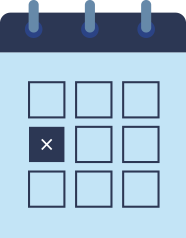

When?
During the 7-month period that:Starts 3 months before your 25th month of getting Social Security or RRB disability benefits Includes your 25th month of getting disability benefits
Ends 3 months after your 25th month of getting disability benefits
| If you join | Your coverage begins |
|---|---|
| During one of the 3 months before you first get Medicare | The first day of your 25th month of entitlement to disability payments |
| During your 25th month of getting disability | The first day of the month after you ask to join the plan |
| During one of the 3 months after your 25th month of getting disability | The first day of the month after you ask to join the plan |
I'm already eligible for Medicare because of a disability, and I turned 65.
What can I do?
* Sign up for a Medicare Advantage Plan and/or a Medicare Prescription Drug Plan.* Switch from your current Medicare Advantage Plan or Medicare Prescription Drug Plan to another plan.
* Drop a Medicare Advantage Plan or a Medicare Prescription Drug Plan completely.


When?
During the 7-month period that:* Starts 3 months before the month you turn 65
* Includes the month you turn 65
* Ends 3 months after the month you turn 65
If you sign up for a Medicare Advantage Plan during this time, you can drop that plan any time during the next 12 months and go back to Original Medicare.
I don't have Medicare Part A, and I enrolled in Medicare Part B during the Part B General Enrollment Period (January 1–March 31).
What can I do?
Sign up for a Medicare Prescription Drug Plan.When?
April 1–June 30Open Enrollment Period for Medicare Advantage and Medicare prescription drug coverage.
What can I do?
* Change from Original Medicare to a Medicare Advantage Plan.* Change from a Medicare Advantage Plan back to Original Medicare.
* Switch from one Medicare Advantage Plan to another Medicare Advantage Plan.
* Switch from a Medicare Advantage Plan that doesn't offer drug coverage to a Medicare Advantage Plan that offers drug coverage.
* Switch from a Medicare Advantage Plan that offers drug coverage to a Medicare Advantage Plan that doesn't offer drug coverage.
* Join a Medicare Prescription Drug Plan.
* Switch from one Medicare drug plan to another Medicare drug plan.
* Drop your Medicare prescription drug coverage completely.
When?
October 15–December 7Medicare Advantage Open Enrollment Period.
Enrollment Period
Medicare Advantage Open Enrollment Period
What can I do?
* If you’re in a Medicare Advantage Plan (with or without drug coverage), you can switch to another Medicare Advantage Plan (with or without drug coverage).* You can drop your Medicare Advantage Plan and return to Original Medicare. You'll also be able to join a Medicare Prescription Drug Plan.
What can't I do?
* Switch from Original Medicare to a Medicare Advantage Plan.* Join a Medicare Prescription Drug Plan if you're in Original Medicare.
* Switch from one Medicare Prescription Drug Plan to another if you're in Original Medicare.
If you enrolled in a Medicare Advantage Plan during your Initial Enrollment Period, you can change to another Medicare Advantage Plan (with or without drug coverage) or go back to Original Medicare (with or without a drug plan) within the first 3 months you have Medicare.
When?
January 1–March 31
5-star special enrollment period
Medicare uses information from member satisfaction surveys, plans, and health care providers to give overall performance star ratings to plans. A plan can get a rating between 1 and 5 stars. A 5-star rating is considered excellent. These ratings help you compare plans based on quality and performance. Medicare updates these ratings each fall for the following year.
What Medicare Part D drug plans cover
Each plan that offers prescription drug coverage through Medicare Part D must give at least a standard level of coverage set by Medicare. Plans can vary the list of prescription drugs they cover (called a formulary) and how they place drugs into different "tiers" on their formularies.List of covered prescription drugs (formulary)
Most Medicare drug plans (Medicare Prescription Drug Plans and Medicare Advantage Plans with prescription drug coverage) have their own list of what drugs are covered, called a formulary. Plans include both brand-name prescription drugs and generic drug coverage. The formulary includes at least 2 drugs in the most commonly prescribed categories and classes. This helps make sure that people with different medical conditions can get the prescription drugs they need. All Medicare drug plans generally must cover at least 2 drugs per drug category, but plans can choose which drugs covered by Part D they will offer.The formulary might not include your specific drug. However, in most cases, a similar drug should be available. If you or your prescriber (your doctor or other health care provider who’s legally allowed to write prescriptions) believes none of the drugs on your plan’s formulary will work for your condition, you can ask for an exception.
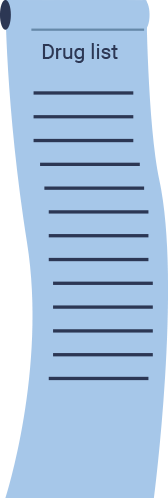

Generic drugs
The Food and Drug Administration (FDA) says generic drugs are copies of brand-name drugs and are the same as those brand-name drugs in: * dosage form* safety
* strength
* route of administration
* quality
* performance characteristics
* intended use

Generic drugs use the same active ingredients as brand-name prescription drugs. Generic drug makers must prove to the FDA that their product works the same way as the brand-name prescription drug.
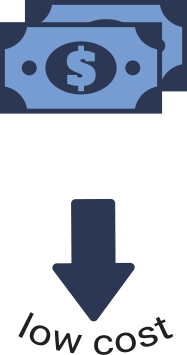
Tiers
To lower costs, many plans offering prescription drug coverage place drugs into different “tiers” on their formularies. Each plan can divide its tiers in different ways. Each tier costs a different amount. Generally, a drug in a lower tier will cost you less than a drug in a higher tier.Here's an example of a Medicare drug plan's tiers (your plan’s tiers may be different):
* Tier 1—lowest copayment : most generic prescription drugs
* Tier 2—medium copayment: preferred, brand-name prescription drugs
* Tier 3—higher copayment: non-preferred, brand-name prescription drugs
* Specialty tier—highest copayment: very high cost prescription drugs

Monthly premium for drug plans
Most Medicare Prescription Drug Plans charge a monthly fee that varies by plan. You pay this in addition to the Medicare Part B premium. If you join a Medicare Advantage Plan (Part C) or Medicare Cost Plan that includes Medicare prescription drug coverage, the plan's monthly premium may include an amount for drug coverage.Get your premium automatically deducted
Contact your drug plan (not Social Security) if you want your premium deducted from your monthly Social Security payment. Your first deduction will usually take 3 months to start, and 3 months of premiums will likely be deducted at once.After that, only one premium will be deducted each month. You may also see a delay in premiums being withheld if you switch plans. If you want to stop premium deductions and get billed directly, contact your drug plan.
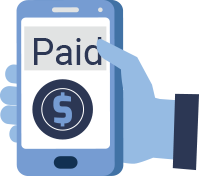
How much does Part D cost?
Most people only pay their Part D premium. If you don't sign up for Part D when you're first eligible, you may have to pay a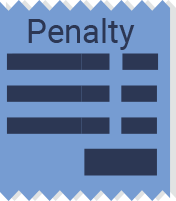
Part D late enrollment penalty
The late enrollment penalty is an amount added to your Medicare Part D monthly premium. You may owe a late enrollment penalty if, for any continuous period of 63 days or more after your Initial Enrollment Period is over, you go without one of these: * A Medicare Prescription Drug Plan (Part D)* A Medicare Advantage Plan (Part C) (like an HMO or PPO) or another Medicare health plan that offers Medicare prescription drug coverage
* Creditable prescription drug coverage

How much is the Part D penalty?
The cost of the late enrollment penalty depends on how long you went without Part D or creditable prescription drug coverage.Medicare calculates the penalty by multiplying 1% of the 'national base beneficiary premium' ($32.74 in 2020) times the number of full, uncovered months you didn't have Part D or creditable coverage. The monthly premium is rounded to the nearest $.10 and added to your monthly Part D premium.
AN EXAMPLE:
Mrs. Sanchez is currently eligible for Medicare, and her Initial Enrollment Period ended on May 31, 2016. She doesn't have prescription drug coverage from any other source. She didn't join by May 31, 2016, and instead joined during the Open Enrollment Period that ended December 7, 2018. Her drug coverage was effective January 1, 2019.2019
Since Mrs. Sanchez was without creditable prescription drug coverage from June 2016–December 2018, her penalty in 2019 was 31% (1% for each of the 31 months) of $33.19 (the national base beneficiary premium for 2019) or $10.29. Since the monthly penalty is always rounded to the nearest $0.10, she paid $10.30 each month in addition to her plan's monthly premium.Here's the math:
.31 (31% penalty) × $33.19 (2019 base beneficiary premium) = $10.29$10.29 rounded to the nearest $0.10 = $10.30
$10.30 = Mrs. Sanchez 's monthly late enrollment penalty for 2019
2020
In 2020, Medicare recalculated Mrs. Sanchez 's penalty using the 2020 base beneficiary premium ($32.74). So, Mrs. Sanchez 's new monthly penalty in 2020 is 31% of $32.74 or $10.15 each month. Since the monthly penalty is always rounded to the nearest $0.10, she pays $10.20 each month in addition to her plan's monthly premium.Here's the math:
.31 (31% penalty) × $32.74 (2020 base beneficiary premium) = $10.15$10.15 rounded to the nearest $0.10 = $10.20
$10.20 = Mrs. Sanchez 's monthly late enrollment penalty for 2020
How do I know if I owe a penalty?
After you join a Medicare drug plan, the plan will tell you if you owe a penalty and what your premium will be. In general, you'll have to pay this penalty for as long as you have a Medicare drug plan.

What if I don't agree with the late enrollment penalty?
You may be able to ask for a "reconsideration." Your drug plan will send information about how to request a reconsideration. Complete the form, and return it to the address or fax number listed on the form. You must do this within 60 days from the date on the letter telling you that you owe a late enrollment penalty. Also send any proof that supports your case, like a copy of your notice of creditable prescription drug coverage from an employer or union plan.What happens if Medicare's contractor decides the penalty is wrong?
If Medicare’s contractor decides that all or part of your late enrollment penalty is wrong, the Medicare contractor will send you and your drug plan a letter explaining its decision. Your Medicare drug plan will remove or reduce your late enrollment penalty. The plan will send you a letter that shows the correct premium amount and explains whether you'll get a refund.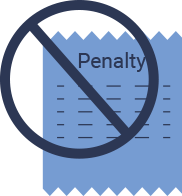

Do I have to pay the penalty even if I don't agree with it?
By law, the late enrollment penalty is part of the premium, so you must pay the penalty with the premium. You must also pay the penalty even if you've asked for a reconsideration. Medicare drug plans can disenroll members who don't pay their premiums, including the late enrollment penalty portion of the premium.How soon will I get a reconsideration decision?
In general, Medicare’s contractor makes reconsideration decisions within 90 days. The contractor will try to make a decision as quickly as possible. However, you may request an extension. Or, for good cause, Medicare’s contractor may take an additional 14 days to resolve your case.
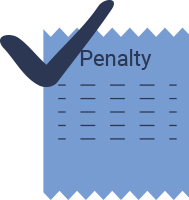
What happens if Medicare's contractor decides the penalty is correct?
If Medicare’s contractor decides that your late enrollment penalty is correct, the Medicare contractor will send you a letter explaining the decision, and you must pay the penalty.How Part D works with other insurance
Employer or union health coverage
Employer or union health coverage refers to health coverage from your, your spouse's, or other family member's current or former employer or union. If you have prescription drug coverage based on your current or previous employment, your employer or union will notify you annually about whether your prescription drug coverage is creditable.COBRA
There may be reasons why you should take Medicare Part B instead of, or in addition to, COBRA. If you take COBRA and it includes creditable prescription drug coverage, you'll have a special enrollment period to join a Medicare Prescription Drug Plan without a penalty when COBRA ends.Medicare Supplement Insurance (Medigap) policy with prescription drug coverage
It may be to your advantage to join a Medicare Prescription Drug Plan because most Medigap drug coverage isn't creditable. You may pay more if you join a drug plan later.Medigap policies can no longer be sold with prescription drug coverage, but if you have drug coverage under a current Medigap policy, you can keep it. If you join a Medicare drug plan, your Medigap insurance company must remove the prescription drug coverage under your Medigap policy and adjust your premiums.
Medicaid
Your drug costs are covered by Medicare. You'll need to join a Medicare Prescription Drug Plan for Medicare to pay for your drugs.In most cases, you'll pay a small amount for your covered drugs. If you have full coverage from Medicaid and live in a nursing home, you pay nothing for covered prescription drugs.
If you have full coverage from Medicaid and live in an assisted living or adult living facility, or a residential home, you'll pay a small copayment for each drug.
If you don't join a drug plan, Medicare will enroll you in one to make sure you don't miss a day of coverage.
Supplemental Security Income Benefits
If you get benefits or help from your state Medicaid program paying your Medicare premiums, you need to join a Medicare Prescription Drug Plan for Medicare to cover your drugs. You automatically qualify for Extra Help with your prescription drug costs. If you don't join a plan, Medicare will enroll you in one to make sure you don't miss a day of coverage.State Pharmaceutical Assistance Program
Each state decides how its State Pharmaceutical Assistance Program (SPAP) works with Medicare prescription drug coverage. Some states give extra coverage when you join a Medicare Prescription Drug Plan.Long-term care facility
Long-term care pharmacies contract with Medicare Prescription Drug Plans to provide drug coverage to their residents. If you're entering, living in, or leaving a nursing home, you'll have the opportunity to choose or switch your Medicare drug plan. This allows you to choose a plan that contracts with your nursing home's pharmacy.HUD housing assistance
If you get housing assistance from the Department of Housing and Urban Development (HUD), you may want to join a Medicare Prescription Drug Plan.If you qualify for Extra Help, you won't lose your housing assistance. However, your housing assistance may be reduced as your prescription drug spending decreases. The value of the Extra Help paying your drug costs will make up for any decrease in your housing assistance.
